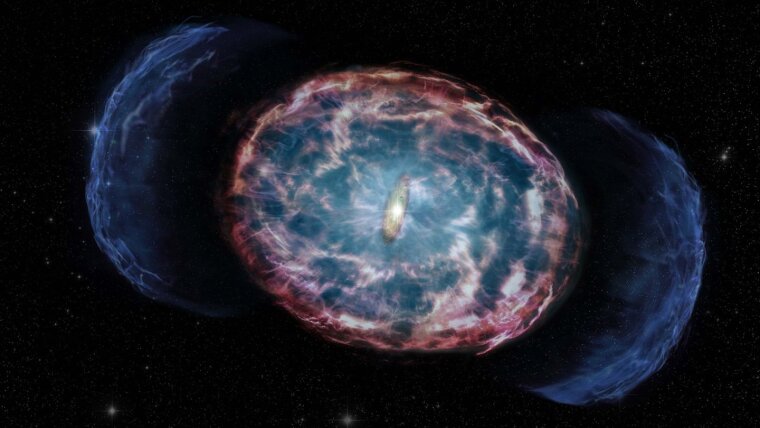
An international research team has been studying the aftermath of a gigantic cosmic explosion with the help of NASA’s »Chandra X-ray Observatory«. The team also included physicists from the University of Jena, who provided detailed predictions and simulations that made it possible to interpret Chandra’s X-ray data.
By Ute Schönfelder
A »kilonova« is the massive explosion that occurs when two neutron stars merge. The »GW170817« kilonova in the Hydra constellation is the first ever object where both gravitational waves and electromagnetic radiation could be measured. It is called »GW170817« because it was discovered on 17 August 2017, when two laser interferometers – LIGO (in the USA) and Virgo (in Italy) – detected gravitational waves that coincided with a burst of gamma rays.
Jets of matter emitted from merged neutron stars
Scientists had previously assumed that the debris of merged neutron stars emitted visible and infrared light, which is produced when radioactive elements decay. In the case of »GW170817«, visible light and infrared radiation could indeed be observed several hours after the gravitational waves. However, the neutron star merger looked very different in the X-ray spectrum: Immediately after discovering »GW170817«, Chandra turned its X-ray vision to the object and detected… nothing. It wasn’t until a few days had passed that Chandra was able to identify »GW170817« as a point source of X-rays.
The researchers have offered an explanation: The merged neutron stars emit a narrow »jet« of high-energy particles that is »off-axis«, i.e., not aimed directly at Earth. They suspect that Chandra was originally observing the narrow jet from the side and therefore did not see any X-rays immediately after detecting the gravitational waves. Over time, however, the emitted material slowed down and the jet cone widened as it collided with surrounding matter. This caused the jet cone to expand further and further into Chandra’s direct line of sight, allowing the X-rays to be measured.
The X-rays emitted by the jet have been fading since the start of 2018 as the jet has continued to slow down and expand. However, the team found that the decrease in brightness stopped, and the radiation remained constant from March 2020 until the end of 2020.
One possible explanation for this new source of X-rays is the theory that the expanding debris from the merger created a »shock« similar to the sonic boom of a supersonic aeroplane. This shock heated up surrounding materials and the heating generated radiation, resulting in a phenomenon known as »kilonova afterglow«. An alternative explanation is that the new X-rays were due to matter falling into a black hole which must have formed after the neutron stars merged.
In order to determine which of the two explanations is correct, the researchers will have to keep observing »GW170817« and measure possible radio waves in addition to the X-rays. If it is a kilonova afterglow, the scientists expect the radio emission to get brighter over time. If it is matter falling into a newly formed black hole, however, the X-ray emission should remain constant or decrease rapidly and no radio waves will be emitted.
The observations can be explained by Einstein’s theory of relativity
This is where Prof. Dr Sebastiano Bernuzzi and the former doctoral candidate Vsevolod Nedora from the University of Jena come into play. They have used a large set of simulations to analyse the mass outflows from which the kilonova signal emanates and to calculate the expected kilonova afterglow. They have found a match with the Chandra observations. While more radiation has recently been observed by the Chandra telescope, radio waves are yet to be detected in conjunction with the X-rays.
Original publication:
Evidence for X-ray Emission in Excess to the Jet Afterglow Decay 3.5 yrs After the Binary Neutron Star Merger GW 170817, The Astrophysical Journal Letters (2022); https://doi.org/10.3847/2041-8213/ac504aExternal link